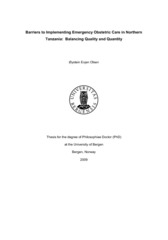| dc.contributor.author | Olsen, Øystein Evjen | en_US |
| dc.date.accessioned | 2010-07-07T11:07:19Z | |
| dc.date.available | 2010-07-07T11:07:19Z | |
| dc.date.issued | 2010-06-04 | eng |
| dc.identifier.isbn | 978-82-308-1529-8 (print version) | en_US |
| dc.identifier.uri | https://hdl.handle.net/1956/3990 | |
| dc.description.abstract | Background: Improving obstetric care is one key factor for the achievement of the millennium development goals concerning maternal and child mortality. Earlier studies of barriers to implementation of health policies, including plans to improve obstetric care, show that there is a major shortfall in the provision and utilization of services in a developing country such as Tanzania. Only scattered evidence exists on how these findings relate to the health system itself and the ability of the system to provide minimum quality care. Aims: The main objective of this thesis is to evaluate health system barriers to facility utilization and facility deliveries of adequate quality through the use of EmOC as a monitoring tool in a resource poor environment such as northern Tanzania. The thesis attempts to contribute to increased understanding of the importance of quality in balance with quantity of health services to improve utilization of services in the community. Material and methods: The study was conducted in six districts in northern Tanzania, and included all facilities in each district (n=129). Each facility in the study districts was assessed in terms of its supply of Emergency Obstetric Care (EmOC) services using pretested and validated assessment guidelines developed by UNICEF/WHO/UNFPA. Data were collected using a facility survey tool including information relevant specifically to the EmOC indicators. Other data sources were the national health management information systems, official planning documents, population surveys and administrative records. Results: Overall there is a very low availability of Basic Emergency Obstetric Care (BEmOC) units in the study area (1.6/500,000 people). Comparatively there is a high availability of Comprehensive Emergency Obstetric Care (CEmOC) units (4.6/500,000 people). There is a large urban / rural variation. The overall provision of Caesarian sections was 4.6%, also lower than the UN guidelines stipulate (5% – 15 %). On average 1.7 BEmOC qualified staff were available at dispensary level and 7.3 BEmOC qualified staff available at health center level. There were on average only 2.5 CEmOC qualified staff at first referral levels. Compared to global figures the availability of staff per population in Tanzania is very low. There is considerable bypassing of services. Delivering mothers seek perceived quality services, often provided only in urban areas, or by voluntary agencies in rural areas. Discussion: Using the EmOC tool was useful to assess availability and utilization of health services. Our data suggest that one of the most important determinants of access to quality care is not the knowledge of the mother or her ability to get to a facility, but the lack of quality care provided at the facility. Of concern is the total provision of good-quality services, accessible to all but not necessarily with the same overall coverage, given the severe resource constraints. The issue at stake is not coverage, but health care quality, accessibility and trust. A high coverage of inadequate quality is not pro-poor. | en_US |
| dc.language.iso | eng | eng |
| dc.publisher | The University of Bergen | eng |
| dc.relation.haspart | Paper I: Health Policy and Planning 20(3), Olsen, O. E.; Ndeki, S.; Norheim, O. F., Availability, distribution and use of emergency obstetric care in northern Tanzania, pp. 167-175. Copyright 2005 the Authors. Published by Oxford University Press in association with The London School of Hygiene and Tropical Medicine. Full text not available in BORA due to publisher restrictions. The published version is available at: <a href="http://dx.doi.org/10.1093/heapol/czi022" target="_blank"> http://dx.doi.org/10.1093/heapol/czi022</a> | en_US |
| dc.relation.haspart | Paper II: International Journal of Gynecology and Obstetrics 87(1), Olsen, O. E.; Ndeki, S.; Norheim, O. F., Complicated deliveries, critical care and quality in emergency obstetric care in northern Tanzania, pp. 98-108. Copyright 2004 International Federation of Gynecology and Obstetrics. Published by Elsevier Ireland. Full text not available in BORA due to publisher restrictions. The published version is available at: <a href= "http://dx.doi.org/10.1016/j.ijgo.2004.07.002" target="_blank"> http://dx.doi.org/10.1016/j.ijgo.2004.07.002</a> | en_US |
| dc.relation.haspart | Paper III: Human Resources for Health 3(5), Olsen, O. E.; Ndeki, S.; Norheim, O. F., Human resources for emergency obstetric care in northern Tanzania: distribution of quantity or quality?. Copyright 2005 Olsen et al; licensee BioMed Central Ltd. Reproduced with permission. Published version. The published version is also available at: <a href="http://dx.doi.org/10.1186/1478-4491-3-5" target="_blank"> http://dx.doi.org/10.1186/1478-4491-3-5</a> | en_US |
| dc.title | Barriers to Implementing Emergency Obstetric Care in Northern Tanzania: Balancing Quality and Quantity | en_US |
| dc.type | Doctoral thesis | |
| dc.rights.holder | Copyright the author. All rights reserved | |
| dc.rights.holder | The author | |
| dc.subject.nsi | VDP::Medisinske Fag: 700::Helsefag: 800::Samfunnsmedisin, sosialmedisin: 801 | nob |


